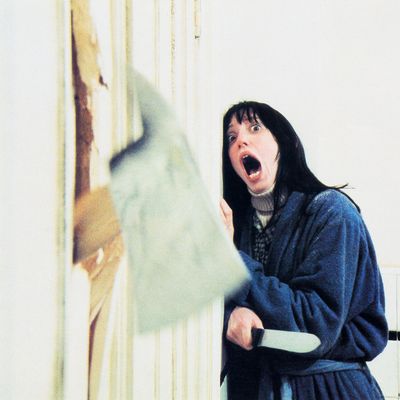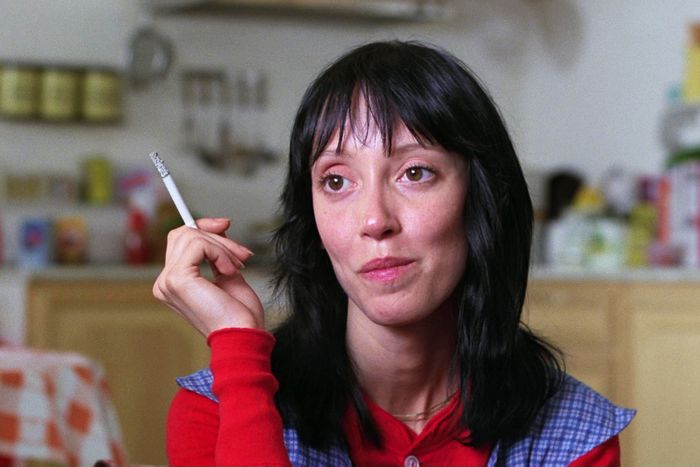
This article was originally published on November 8, 2019. We’re republishing it with the news of Shelley Duvall’s death.
It may sound perverse, possibly even stupid, to travel nearly 4,000 miles to watch a movie you’ve already seen dozens of times. But that’s exactly what I did in 2019 when I attended a late-night screening of Stanley Kubrick’s 1980 horror classic The Shining, along with about a thousand other people at the Cannes Film Festival in France. It wasn’t a new cut or anything, but it was a beautiful 4K restoration (in advance of the Blu-ray that fall), with Kubrick’s daughter Katharina, his former assistant Leon Vitali, and director Alfonso Cuarón in attendance. The chance to revisit this film again on a huge screen — especially with its new sequel, Doctor Sleep, on the horizon — was irresistible.
The movie, as you might have heard, is pretty good. But I wasn’t quite prepared for what I witnessed this time around. Specifically, at that massive scale, I gained a newfound respect for one of the film’s most divisive elements: Shelley Duvall’s performance as Wendy Torrance, the terrified wife of murderous author Jack Torrance (Jack Nicholson).
Many viewers — even some who love The Shining — find Duvall’s acting strangely cartoonish with its wild expressions of anxiety and fear. It was certainly much maligned back in 1980, but then again, so was the movie itself. (Both Duvall and Kubrick were nominated for Razzies at the time.) Stephen King himself, famously not a fan of the film adaptation of his book, was downright offended by how the picture depicted Wendy, who was more proactive and heroic in his novel. For King, the movie’s Wendy was “one of the most misogynistic characters ever put on film. She’s basically just there to scream and be stupid.”
Duvall’s Wendy has never struck me as “stupid,” but there is something quite awkward to her delivery, like someone worried about tripping over her lines. Maybe there was some unfortunate real-life resonance to this; she may well have been worried about getting her lines wrong in real life. As the film’s screenwriter Diane Johnson once put it, “I was interested in the Wendy character and gave her some sympathetic lines. Although I did not watch the filming, Shelley Duvall told me later that she and Kubrick were a little at odds, and he had cut a lot of her lines. He said, as I remember, that she couldn’t say them. Whichever it was, the result was not the ‘round’ Wendy as I had hoped to characterize her (and so did King), but a moist character reduced to tears and whimpers.”
At the same time, Duvall’s admittedly odd performance has always been part of the uncanny, handmade charm of The Shining. Over the years, many have come around to her portrayal, to be sure, maintaining that there is something unsettling about it, another one of the film’s several bold, somewhat discomforting choices. But something strange happens when you see the performance, in all its exposed-nerve glory, on a massive screen. It becomes inescapable — an existential fact. You can’t ignore it, or let your mind wander while watching it. You have to confront it, and reckon with it. And looking into Duvall’s huge eyes from the front row of a theater, I found myself riveted by a very poignant form of fear. Not the fear of an actor out of her element, or the more mundane fear of a victim being chased around by an ax-wielding maniac. Rather, it was something far more disquieting, and familiar: the fear of a wife who’s experienced her husband at his worst, and is terrified that she’ll experience it again.
Wendy is clearly an abused woman. Watch the way she hesitates before telling a pediatrician, early in the film, that Jack once accidentally dislocated their young son Danny’s shoulder during a drunken rage. It’s an awkward scene, and the kind of thing that might prompt someone to think that the actress was all wrong for the part. But the hesitation in her delivery is not that of an actor stumbling. It’s the unease of someone who is petrified that merely mentioning such an event to a stranger might somehow animate the darkness again. It’s a vision of trauma, and Duvall nails it.
This becomes even clearer in the light of Nicholson’s performance. To be sure, his acting has come in for its share of criticism as well; he seems way too crazy way too soon in the film, thus presumably denying us the tragic dimension of a family man gradually losing his mind. But unlike Duvall, he usually gets a pass, because he is so snarlingly, compellingly menacing in the picture’s latter half.
In truth, the two performances work distressingly well together. Consider an early scene of the Torrance family in their car as they drive to the Overlook Hotel. Anyone who’s seen The Shining will remember it. Looking out the window, Wendy wonders if the area they’re driving through is where the Donner Party was stranded in the mid-1800s. When young Danny asks what the Donner Party was, Jack, with a sadistic twinkle in his eye, relates to him the story of how a group of settlers, stranded in the Sierra Nevada mountains, had to resort to cannibalism in order to survive. When Wendy expresses concern about Danny hearing such morbid stories, the boy assures her that he already knows all about cannibalism from watching TV. Jack, grinning ear to ear while looking straight ahead, says, somewhat ironically, “See, it’s okay. He saw it on the television.”
There’s a snide, cutting quality to Nicholson’s demeanor in this scene. More than anything, he just seems downright cruel. Thus, his performance goes perfectly alongside Duvall’s fragility. Jack starts off sarcastic, judgmental, angry, and Wendy starts off nervous, frightened, hesitant. Her behavior is a response to his; she’s clearly been brutalized before the movie even begins. This perhaps speaks to some of the changes that Kubrick brought to the character of Wendy. He has been quoted as saying that he never bought the notion of the novel’s more reliant and headstrong version of Wendy staying married to Jack for so long. In his conception, Wendy had to be more “mousy and vulnerable.” (I haven’t seen Doctor Sleep yet, which apparently depicts Wendy in flashbacks. I’ll be curious to see which version of her made it into this new film.)
Once left alone, Jack’s resentments and rage all come exploding to the surface, and his subsequent interactions with Wendy are less like the horror-flick confrontations of slasher and victim and more like the vicious, escalating arguments of a mad husband and his long-suffering wife. These spousal fights, each more brutal than the previous, are where The Shining finds its true horror — at least, before the Steadicam-fueled chase scenes of its final act take over.
Much has been made of The Shining’s supernatural revelations — the existence of ghosts at play in the hotel, the great evils of the past reenacted and revisited over and over again. (This is also why the film lends itself to historical readings, be they about the Holocaust or the genocide of the Native Americans or, uh, the moon landing.) But for all its nods to spectral figures and haunted-house tales, The Shining ultimately seems most interested in exploring the brutality within the family unit. If the horror genre is founded on the idea of helplessness, in The Shining that helplessness comes not from a gathering of external menace, but from the terrifying spectacle of domestic discord and violence. We watch the movie with the helplessness of children watching their families fall apart.
And the seeds of that violence are there right at the beginning. In the same way that he has, in the immortal words of one of the ghosts from the hotel, “always been the caretaker,” Jack has also always been the monster tormenting his wife and son. And Shelley Duvall’s traumatized, unforgettable performance as Wendy Torrance is, ultimately, the key that unlocks this idea.



